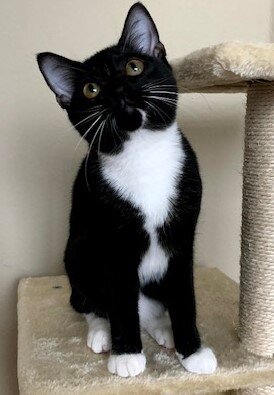Dermatophytosis (Ringworm)
Ringworm is a very misleading name! Ringworm is actually a fungal infection, similar to Athlete’s Foot, which can affect the hair and skin of cats, dogs, and humans. In humans, the infection often causes ring-like lesions, but these are seen less commonly in cats and dogs. In most patients, Ringworm is ‘self-limiting;’ meaning that it will self-cure over time; however, because this infection can be transmitted between animals and humans, it is important that the infection is treated and resolved as quickly as possible.
A classic symptom of Ringworm is a small irritated lesion that is devoid of hair. The lesions will often have scaly and red skin in the center and small pustules (zits) and are most commonly found on/around the ears, face, and paws.
Home remedies for Ringworm include topical antifungal creams, Tea Tree oil diluted with coconut oil or olive oil, antifungal shampoos, topical solutions, or a diluted bleach solution. It is also a good idea to wash any bedding or surfaces that your foster has come in contact with (including cat trees or scratchers) using warm water and a diluted bleach solution or disinfectant, like OdoBan®, to prevent any ringworm spores that may have shed and are waiting for a new host.
If you suspect that your foster cat has ringworm, please let a Desert Paws Administrator know so we can determine a course of treatment. Since ringworm is easily transmitted to both humans and other animals, we encourage you to isolate your foster cat from the other animals and people in your home as soon as you suspect it is carrying Ringworm.
Parasites
Otodectes cynotis (Ear Mites)
Ear mites are tiny parasites that live out their life cycle inside the ear canal where they feed on skin debris. They are quite common and the brown residue that they produce can cause severe irritation, itchiness of the ears, inflammation, and often lead to secondary ear infections. Ear mites are spread mostly by direct contact with another animal that has mites and is especially common in kittens. While an ear mite’s life cycle may be short, they are constantly reproducing, making it very important that the mites, and their eggs, are eradicated as soon as possible.
A thorough cleaning of the ears, using a cotton applique and warm water, or mineral oil, can clear the brown discharge produced by mites and help calm irritation, along with removing dead mites. Topical flea, tick, and mite medications, like Revolution or Advantage, can be applied to the neck of the affected cat once every three weeks for up to two months in order to eliminate live ear mites and their eggs. Acarexx (Ivermectin) can also be applied to the inner ear to eliminate live mites and their eggs. It is also a good idea to wash any bedding or surfaces that your foster has come in contact with using warm water and disinfectant to prevent any mites that may have shed and are waiting for a new host.
If you suspect that your foster cat has a case of ear mites, please let a DPR Administrator know so we can determine a course of treatment. Since ear mites are easily transmitted through physical contact with other animals, we encourage you to isolate your foster cat from the other animals in your home as soon as you suspect they have ear mites.
Fleas & Ticks
It is very common for cats that have come directly from a shelter to have been exposed to fleas and ticks. Finding fleas and/or ticks on your foster cat should be taken very seriously as these parasites can easily “jump ship” and attach themselves to other animals and humans within your home.
Topical flea, tick, and mite shampoos and medications, like Revolution or Advantage, are the most successful solution for eliminating fleas and ticks. It is also a good idea to wash any bedding or surfaces that your foster has come in contact with using warm water and disinfectant to remove any fleas or ticks that may have shed and are waiting for a new host.
If you suspect that your foster cat has a case of fleas and/or ticks, please let a DPR Administrator know so we can determine a course of treatment. Since fleas and ticks are easily transmitted through contact with other animals and humans, we encourage you to isolate your foster cat from the other animals and humans within your home as soon as you suspect it has fleas and/or ticks.
Worms
Gastrointestinal (GI) parasites are common in cats that have spent any amount of time outdoors or in a shelter/pound environment. These parasites can be wormlike (e.g., stomach worms, roundworms, hookworms, tapeworms) or single-celled microscopic organisms (e.g., Isospora, Giardia, Toxoplasma). Symptoms associated with the presence of these parasite infections are fairly nonspecific, such as dull coat, coughing, vomiting, diarrhea, mucoid or bloody/black feces, loss of appetite, or a pot-bellied appearance. If left untreated, these infections may cause potentially life-threatening anemia, perforation of the stomach/intestines, and sometimes death.
If you suspect that your foster cat has symptoms associated with an internal parasitic infection, please let a DPR Administrator know so we can determine a course of treatment. Internal parasites like these are most commonly contracted by the affected animal by ingesting soil, feces, or being exposed to another animal that is carrying the parasites; because of this, we encourage you to isolate your foster cat from the other animals within your home as soon as you suspect they have a case of GI parasites.




































